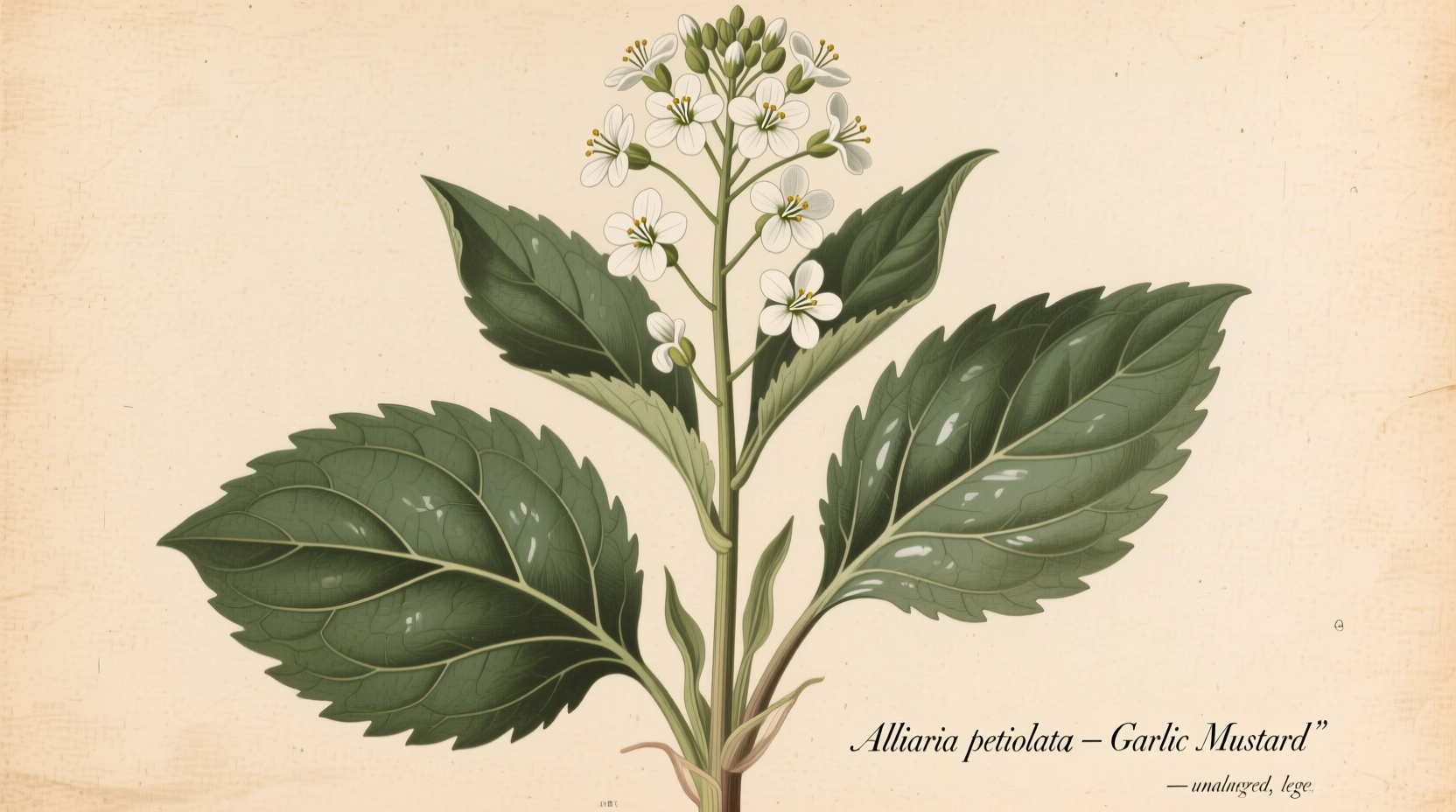Why Garlic Mustard Demands Your Attention
If you've spotted a plant with heart-shaped leaves and a garlic scent in your woodland area, you're likely facing garlic mustard weed—a silent forest destroyer. This invasive species has spread across 34 U.S. states and 10 Canadian provinces, forming dense monocultures that eliminate native wildflowers and disrupt entire ecosystems. Unlike many weeds, garlic mustard actively alters soil chemistry through allelopathy, releasing compounds that inhibit mycorrhizal fungi essential for native plant growth.
Accurate Identification: Spotting the Invader
Correct identification prevents accidental removal of beneficial plants. Garlic mustard displays distinct characteristics throughout its two-year lifecycle:
| Growth Stage | Key Identification Features | Seasonal Timing |
|---|---|---|
| First Year (Rosette) | Circular cluster of kidney-shaped leaves with scalloped edges, emits garlic odor when crushed | Year-round, most visible spring/fall |
| Second Year (Flowering) | 6-40 inch tall stalk with triangular-to-heart-shaped leaves, small white flowers with four petals | April-May in most regions |
| Seed Production | Narrow seed pods (siliques) containing 12-28 black seeds per pod | June-July |

The Ecological Damage: More Than Just a Nuisance
Garlic mustard isn't merely unsightly—it fundamentally alters forest ecosystems. According to research from the USDA Forest Service, a single plant can produce up to 8,000 seeds that remain viable for 5-7 years. The plant's allelopathic chemicals reduce native plant diversity by 40-75% in infested areas, creating cascading effects on insect populations and forest regeneration.
Unlike native plants that co-evolved with local ecosystems, garlic mustard lacks natural predators in North America. The University of Wisconsin Extension documents how infested forests show significantly reduced populations of native spring ephemerals like trillium and bloodroot, with recovery taking decades after garlic mustard removal.
Effective Control Strategies: What Actually Works
Successful garlic mustard management requires understanding its biology and implementing the right approach for your situation:
Manual Removal: The Gold Standard for Small Infestations
For patches under 100 square feet:
- Timing is critical: Pull plants in early spring (April-May) before flowering
- Proper technique: Grasp the base and pull slowly to remove the entire taproot
- Disposal protocol: Bag plants and dispose in trash (never compost)
- Follow-up: Return monthly to catch new seedlings
Chemical Control: Targeted Solutions for Large Areas
For extensive infestations where manual removal isn't feasible:
- Herbicide selection: Use glyphosate-based products (2-5% solution) in early spring
- Application method: Spot-treat individual plants to minimize environmental impact
- Regulatory compliance: Check state regulations—many require licensed applicators
- Timing window: Apply when native plants are dormant but garlic mustard is active
Biological Control: The Emerging Solution
The USDA Agricultural Research Service has approved two weevils (Ceutorhynchus scrobicollis and C. constrictus) as biological controls. These insects specifically target garlic mustard without affecting native species. As reported by the Invasive Plant Biology Laboratory, field trials show these weevils can reduce garlic mustard seed production by 70-90% in established populations.
Timing Matters: The Critical Control Window
Garlic mustard's biennial lifecycle creates specific vulnerabilities:
| Season | Plant Stage | Recommended Action |
|---|---|---|
| Early Spring (March-April) | Rosettes actively growing | Manual removal or herbicide application |
| Late Spring (May) | Flowering stage | Cut flower stalks below soil line immediately |
| Summer (June-July) | Seed production | Remove and destroy seed pods before opening |
| Fall/Winter | Soil seed bank | Monitor for new seedlings; no active control needed |
Preventing Spread: Your Responsibility as a Land Steward
Even careful management can fail if you overlook these critical prevention steps:
- Clean boots, tools, and pet fur after visiting infested areas
- Avoid moving soil from infested to clean areas
- Never transport garlic mustard for culinary use (illegal in many states)
- Participate in local "weed warrior" volunteer programs
The National Park Service emphasizes that consistent management over 2-3 years is essential, as seeds remain viable in soil. Their monitoring data shows that areas receiving three consecutive years of spring treatment achieve 95% reduction in garlic mustard populations.
The Edible Paradox: Why Foraging Isn't the Solution
While garlic mustard is edible and was historically used in European cuisine, harvesting it as a control method creates serious ecological risks:
- Foraging often spreads seeds through improper disposal
- Harvesting stimulates additional growth and seed production
- Many states prohibit intentional harvesting of invasive species
- Native plant recovery requires complete removal, not selective harvesting
As the University of Minnesota Extension warns, "Using garlic mustard in recipes may encourage its spread and undermine control efforts." Complete removal and destruction remains the only ecologically responsible approach.
Long-Term Management: Building Resilient Ecosystems
Successful garlic mustard control requires shifting focus from eradication to ecosystem restoration:
- Plant native species like Virginia bluebells to compete with garlic mustard
- Monitor treated areas for at least five years for new seedlings
- Join regional early detection networks for new infestations
- Document your progress with before-and-after photos
Research from Cornell University's New York Invasive Species Information shows that combining garlic mustard removal with native plant reintroduction increases ecosystem recovery rates by 60% compared to removal alone.











 浙公网安备
33010002000092号
浙公网安备
33010002000092号 浙B2-20120091-4
浙B2-20120091-4